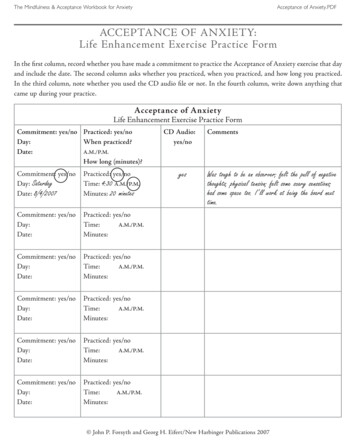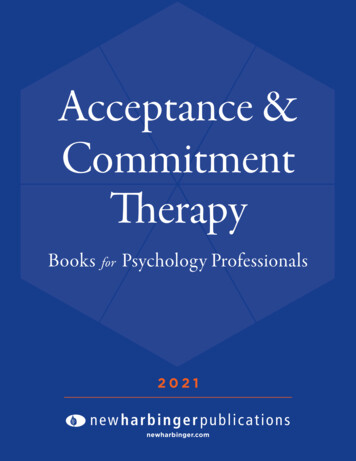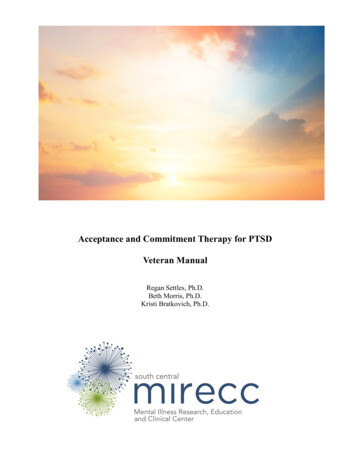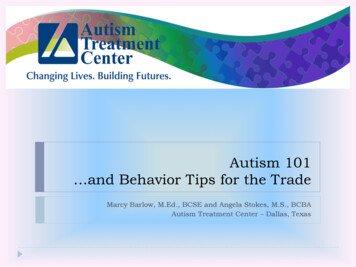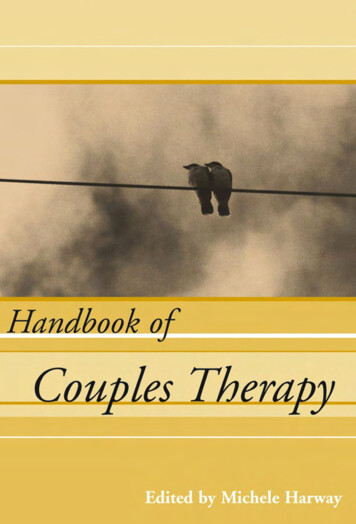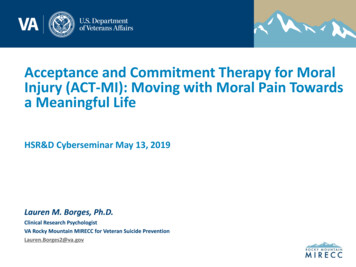
Transcription
Acceptance and Commitment Therapy for MoralInjury (ACT-MI): Moving with Moral Pain Towardsa Meaningful LifeHSR&D Cyberseminar May 13, 2019Lauren.Borges2@va.gov
Acknowledgements Sean Barnes (Co-PI), Jacob Farnsworth (Co-I), Robyn Walser (Co-I), Kent Drescher (Co-I),Wyatt Evans (Co-I), Craig Rosen (Co-I), Lisa Brenner (Consultant), Jason Nieuwsma(Consultant), and Joseph Currier (Consultant) (ACT-MI).Funding Work associated with this study has been made possible by a grant from VA ResearchRehabilitation and Development (1I01 RX002854-01A1) and additional support from theRocky Mountain MIRECC.Disclaimer This presentation is based on work supported, in part, by the Department of VeteransAffairs, but does not necessarily represent the views of the Department of VeteransAffairs or the United States Government.Conflicts of Interest None to report.
Poll Question #1What is your primary role related to mental healthcare? (select all that apply)o Consumero Student, Trainee, or Fellowo Cliniciano Researchero Administrator, Manager, Policy Maker
Poll Question #2Do you work within the Department of Veterans Affairs?o Yeso No
Poll Question #3How familiar are you with Acceptance and Commitment Therapy?o Never heard of it.o I’ve heard of it.o I’ve read about it.o I’ve been trained in it.o I use it.
Poll Question #4How familiar are you with moral injury?o Never heard of it.o I’ve heard of it.o I’ve read about it.o I’ve treated it.
Poll Question #5If you have treated moral injury, which treatments do you most often use(select all that apply)?o Cognitive Processing Therapyo Prolonged Exposureo Adaptive Disclosureo Impact of Killingo Acceptance and Commitment Therapy for Moral Injury
Poll Question #6If you have used evidence based psychotherapies for PTSD (ProlongedExposure, Cognitive Processing Therapy, or Eye Movement Desensitization andReprocessing) to treat moral injury, how satisfied are you in general with theapplication of these interventions to moral injury treatment?o Completely dissatisfiedo Somewhat dissatisfiedo Neutralo Somewhat satisfiedo Completely satisfied
Overview1. Introduction to our group’s conceptual model of moral injury2. Background on the relevance of moral injury to suicide prevention3. Development of Acceptance and Commitment Therapy for MoralInjury (ACT-MI) treatment protocol and results of a case studydemonstrating an application of ACT-MI in a Service Memberexperiencing concurrent suicidal ideation4. Design of a grant-funded randomized controlled acceptability andfeasibility pilot study for ACT-MI
Conceptual Model of Moral Injury
What keeps us connected?
Constructs Useful to the Proposed Definition of MoralInjurySocial Functionalism and Evolutionary Science (Farnsworth et al., 2014; Hayes &Sanford, 2014; Wilson, Hayes, Biglan, & Embry, 2014) Moral emotions serve social purposes. Humans are inherently tribal and moralemotions keep us inside of the tribe or remove us from the tribe if we havecommitted a violation. Not only do emotions communicate to us, emotionscommunicate to the group and allow social commitments.Moral emotions are coordinated responses critical to survival. They are theproduct of factors like variation, selection, and retention in context.Functional Contextualism (Hayes, Wilson, & Strosahl, 2011) A philosophy of science wherein the goal is to predict and influence behavior inthe most parsimonious manner. Within the contextual behavioral sciencecommunity, behavior (overt and covert events) is predicted and influencedbased on the environmental factors in which it emerges and the function itserves.Therefore, moral emotions serve individual and social functionsAND are dependent on contextual factors in the environment A model that accounts for the social functions of moral pain
Moral Injury ModelMorally Injurious Events “A situation occurring in a high-stakes environment where an individualperceives that an important moral has been violated by the actions ofthe self or others.”Moral Pain “The experience of dysphoric moral emotions and cognitions inresponse to a morally injurious event.”Moral Injury “Social, psychological and spiritual suffering stemming from costly orunworkable attempts to manage, control, or cope with the experience ofmoral pain.”(Farnsworth, Drescher, Evans, & Walser, 2017)
Moral Injury Model I feel betrayed by leaderswho I once trusted I saw/was involved in thedeaths of children I did things in war thatbetrayed my personalvalues I am troubled by havingwitnessed others’immoral actsMoralOffense There were times when Iengaged inrevenge/retribution forthings that happenedFarnsworth et al., 2017Moral Pain I violated my own moralsby failing to do somethingI felt I should have done
Moral Injury ModelMoral InjuryDisconnectionfromrelationshipsSuicidal Ideationand BehaviorShameAngerDiscontinuingspiritual practiceDisengagingfrom self-careFarnsworth et al., 2017DisgustGuiltContemptUrge toisolateSelf-blameMoralI amPaina monsterthoughtsThoughtsHumans areblaming othersblamingevilStomachTightness inFlippingchestSubstance UseWorkplacedifficulties
Background on moral injury and the relevance ofmoral injury to suicide prevention
Why is moral injury relevant?Prevalence of morally injurious events among warzone Veterans: 27% of soldiers endorsed facing dilemmas to which they were unsure ofhow to respond (MHAT-V, 2008b) 11% acknowledged engaging in morally transgressive events whiledeployed, 26% of Veterans reported transgressions by others, and 26%reported moral betrayal (Wisco et al., 2017)Exposure to morally injurious events as a risk factor for: Substance use (Battles et al., 2018; Kelley et al., 2019)Depression (Currier et al., 2014)PTSD (Bryan et al., 2018; Maguen et al., 2010)Suicidal ideation and behavior (Bryan et al., 2018; Kelley et al., 2019)
Moral Injury and PTSD Moral injury can be conceptualized as a construct that is both related to anddistinct from PTSD (Currier, McDermott, Farnsworth, & Borges, 2019; Bryan, Bryan, Roberge, Leifker,& Rozek, 2018; Sun et al., 2019). Relationship between betrayal-based potentially morally injurious events(PMIEs) and PTSD mediated by anger, marginal evidence supporting therelationship between perpetration-based PMIEs and PTSD mediated by guiltand shame (Jordan et al., 2017; Bryan et al., 2018). In a qualitative study, 12 of 14 Veterans who were recruited based on alifetime history of moral injury (within a year of completing an EBP for PTSD)reported persistent difficulties in functioning related to moral injury after 8or more sessions of Cognitive Processing Therapy (CPT) and/or ProlongedExposure (PE) (Borges et al., in preparation). The vast majority of Veterans struggling with moral injury related issuesreceive treatment for PTSD. The efficacy of these interventions for moralinjury is still unknown. EBP’s for PTSD are fantastic, but may not always sufficiently addressmoral injury related processes (Steenkamp et al., 2015).
Moral Injury and Suicidal Ideation and Behavior Twenty Veterans die by suicide each day. Exposure to morally injurious events (MIEs) is a risk factor for suicidal ideation andbehavior in Service Members and Veterans. Interaction between PTSD and moral injuryassociated with increased risk for suicidal ideation and suicide attempts. (Bryan et al., 2018;Bryan et al., 2015). Self and other directed moral injury (Expressions of Moral Injury Scale) stronglyassociated with suicidal ideation, self-judgment strongly associated with suicidal ideation,relationship between self-directed moral injury and suicidal ideation was strengthened athigher levels of self-judgment (Kelley et al., 2019). Firing a weapon and killing in combat are associated with suicidal ideation in OEF/OIFVeterans (Tripp et al., 2016). Evidence based psychotherapies for PTSD may not sufficiently target the pathwaysmaintaining suffering in moral injury, causing suicidal ideation and behavior to persist. Treatments are needed to target moral injury and co-occurring suicidal ideation andbehavior.
Need for Evidence Based Psychotherapies Targeting the PathwaysMaintaining Suffering in Moral InjuryPsychotherapies proposed for moral injury and related constructs Adaptive Disclosure (Gray et al., 2012; Litz et al., 2009)Impact of Killing (Maguen et al., 2017)Trauma Informed Guilt Reduction (Norman et al., 2014)Acceptance and Commitment Therapy for Moral Injury (Farnsworth*, Borges*,Drescher, & Walser, 2019; Borges, Under Review; Farnsworth et al., 2017)While the literature suggests moral injury is a construct independent ofPTSD, we often treat it clinically as a subset of PTSD Case studies using Prolonged Exposure and Cognitive Processing Therapyhave been shown to treat difficulties associated with moral injury, but theefficacy of these interventions for treating moral injury is still unknown asRCT’s have not yet been published (Held et al., 2017; Paul et al., 2014; Wachen et al.,2016).
ACT-MI Treatment Protocol Development
Existing barriers and needs for an intervention
Phases of ACT-MI Manual Development1. Development of a 6-session group in a PTSD-RRTP program at the PaloAlto VAMC.2. Implementation of the group at the Denver VAMC in the PTSD outpatientclinic.3. Further development and expansion of the group to 12-sessions. Pilotedthe ACT-MI group for 2-years in this format.4. A randomized controlled acceptability and feasibility pilot study wherewe will complete 6 groups of 12-session ACT-MI and 6 groups of 12session Present Centered Therapy (n 72 participants in total). Manualrevisions will take place after 2-group cohorts are completed per thegrant.Farnsworth, J.K.*, Borges, L. M.*, Drescher, K. D., & Walser, R. D (2019). Acceptance and Commitment Therapy for Moral Injury (ACT-MI).Unpublished Treatment Manual*Both authors contributed equally to this treatment manual
Why ACT is a good fit for Moral Injury: ACT CoreProcessesOpenAwareEngagedPresent MomentVA ACT Training tionSelf-as-Context
Why ACT is a good fit for Moral Injury: MoralHealing(Farnsworth*, Borges*, Drescher & Walser, 2019)*Both authors contributed equally to this manual
ACT-MI Case Study to Illustrate our ProtocolUnder Development
De-identified Case Description Service Member consented to using the below information in presentations andpublication. Information is de-identified to protect confidentiality. Service Member deployed to Afghanistan from 2008-2009 as a human intellegiencecollector. Received treatment for PTSD via Cognitive Processing Therapy. In addition to a history ofPTSD, he reported a history of depression, suicidal ideation and behavior, and experiencedabuse as a child. Scored 66 out of 80-points on the Moral Injury Questionnaire-Military version (MIQ-M)indicating significant exposure to MIEs (required to befriend members of terroristorganizations and use intellgience collected to take the lives of men, women, children). Early 30‘s, married with two young daughters, family still practicing religion (he does notidentify with this religion any longer). Service Member‘s friend attempted suicide midway through our course of treatment.Another fried died during the course of our work togehter. Goal for treatment to "take off the mask.it‘s a lot easier to put on the mask thanactually look at yourself and try to get better.“ Reported difficulties engaging with meaning in his life and feeling isolated.
Telehealth ACT-MI Session Content: De-Identified CaseStudy Sessions 1 and 2: values clarification andcreative hopelessness-Related to values clarification his primarygoal was to "reconcile my actions with myvalues." Sessions 3 through 5: contacting the present moment, limitationsof controlling moral pain-In the tug of war: "I can see the sergeant but I can‘t see me."Reported experiencing fear, disgust, horror, and comfort in thisscenario. He noticed urges to become the sergeant or abandonthe sergeant noting that in either scenario "part of me dies."(Farnsworth*, Borges*, Drescher & Walser, 2019)*Both authors contributed equally to this manual
Telehealth ACT-MI Session Content: De-Identified Case Study Sessions 6 through 9: observing and accepting moral pain andstories about himself-Formerly a ballroom dancer, generated the metaphor of"ballroom dancing with my moral pain" to practice approachinghis pain and holding it lightly while moving towards his values.-Practiced observing stories related to his moral pain and identifiedthe function of these stories "we develop stories to hide our painfrom ourselves and others."-Started to engage in value of spirituality for the first time sincechildhood: "I get a sense of spiritual fulfilment through helping others. "-"I don’t think the pain will ever go away and I’m not sure I want it to. I can mourn thelosses I have experienced without lessening my own worth." Sessions 10 through 12: holding pain/stories about myself and others lightly for thesake of my values-Tug of war self-compassion exercise: In observing himself in the tug of war, the servicemember said "my heart is breaking my body wants to shut down you have to acceptwho you are which includes who you have been."(Farnsworth*, Borges*, Drescher & Walser, 2019)*Both authors contributed equally to this manual
Telehealth ACT-MI Session Content: De-identified Case Study Weekly experiential exercises in-session mapping onto the skill practiced thatweek and ACT processes in general. Weekly bold moves to practice engaging flexibly with values in the presence ofpain.-Engaged in values related to family relationships, physical self-care, and learning early in treatment. Beganengaging in values of spirituality (e.g., learning that contributing to others connects him to a larger purpose)and emotional self-care (e.g., creating a work space for himself, purchasing luthier equipment, and registeringa small guitar business) during the last half of treatment. Additional weekly skills practice related to content practiced in session thatweek (e.g., observing facets of moral pain). Reviewed safety plan together in session and updated with ACT-MI consistentskills (in particular identifying more specific warning signs, coping skills, andways to make his environment safe that were consistent with treatment goals). Service Member’s wife participated in post-treatment feedback session. Service Member’s Vet Center provider followed-up our course of care byencouraging him to continue engaging in bold moves practice to facilitategeneralization of skills.(Farnsworth*, Borges*, Drescher & Walser, 2019)*Both authors contributed equally to this manual
Telehealth ACT-MI Session Content: Bold Moves TrackingValues and moral pain as two sides of the same coinWhich Bold Moves did you practice on this day?Day1Day2Day3Day4Day5Day6(Farnsworth*, Borges*, Drescher & Walser, 2019)Day authors contributed equally to this manual*Both7(Farnsworth*, Borges*, Drescher & Walser, 2019)*Both authors contributed equally to this manualWhat values were theyconnected to?What did you notice before, during orafter your Bold Move?(thoughts, emotions, sensations,urges, behaviors)
Values Related Results: Valued Living Questionnaire (VLQ) andNarrative Evaluation of Intervention Interview (NEII)“I want to be able to thrive both for myself and for the sake of those around me Iwant to be able to feel. To identify what I feel and interact with it. Moving forward Iwant my life to have purpose and meaning. I want to connect to my values of familyand spirituality To be there for my wife, my children, and for me. to recognize thatregardless of what’s happened I still have value.”“I think the biggest thing I did during the intervention that helped was trying toaccept the fact that I can value something without living up to that value that it’smore about moving in the right direction than it is about being or not being anyparticular thing.”VLQ SCORES ACROSS onth Follow-Up
Experiential Willingness Related Results: Acceptance and Action Questionnaire-II(AAQ-II), Cognitive Fusion Questionnaire for Moral Injury (CFQ-MI), and NEII“With the focus of this intervention being acceptance of moral pain, it helped me to makepeace with the fact that I will feel moral pain based on my moral injuries and that is ok. It’s agood thing to feel pain and mourn loss of life that does not make me weak or less humanor anything else. It means that I am human that I am able to feel.”“The intervention did not lessen the amount of pain that I feel. It did not make it so that I nolonger feel pain for my morally injurious events What it did it made it so that I couldconnect better with that pain so I could interact with that pain with moreresponsibility and it helped me to identify with areas that I connect to and be able toaccept that in my life I will always feel a lot of moral pain and I am still able to feelhappiness and feel connected to other people.”AAQ-II Scores Across Treatment50454035302520151050CFQ-MI Scores Across Treatment50454035302520151050Pre-Treatment Mid-Treatment reatmentPost-TreatmentOne-MonthFollow-Up
Discussion and Implications for Case Study Results of the case study suggest that ACT-MI is acceptable (NEII and ClientSatisfaction Questionnaire-8 31/32 points) in a telehealth format for aService Member struggling with difficulties in functioning related to moralinjury (Borges, Under Review). The service member was able to engage in valued behavior that was criticalfor his recovery only when he was willing to approach his moral pain (once hestarted approaching intense guilt and shame in the presence of self-care andspirituality) Throughout treatment, the Service Member became less stuck inside of thecontent of his suicidal thoughts and plans. Suicide risk assessment required the therapist’s willingness to accept greaterdiscomfort as the client was not physically in her presence. Future studies are needed to understand the efficacy of using ACT-MI totarget co-occurring moral injury and suicidal behavior.
Discussion and Implications for Case Study After completing ACT-MI, the Service Member compared ACT-MI toprevious treatment targeting his morally injurious events on the NEII.He said:“The biggest difference between ACT-MI and CPT is that ACT is focusedspecifically on the idea that I need to accept what has happened andnot so much try to reassign blame for it. With many other treatmentmodalities it has focused on aiding victims and survivors to reassignblame and guilt for what they had been through—in my situation I hadbeen unable to do so because the facts of the matter are that I bear fullresponsibility for the deaths of many people. This treatment was veryeffective in helping me to develop my values so that I can feel painwithout being consumed by it and also focus on striving towards livingup to my values and accepting where I am now instead of comparingmyself to where I was or where I want to be.”
Next Steps: Pilot Randomized ControlledAcceptability and Feasibility Study!
Pilot Study Aims1.Determine the acceptability of ACT-MI and PCT for 72 Veterans endorsingimpairment in functioning associated with moral injury.-Satisfaction reported on a validated measure of client satisfaction ( 70% ofparticipants with 24 Client Satisfaction Questionnaire score)2.Determine the feasibility of the efficacy study design and research procedures.-Participant recruitment rates ( 50% of participants eligible and 30% willingto participate in proposed time frame); fidelity to treatment ( 15% ofdeviations to treatment fidelity), participant completion of the intervention ( 70% treatment drop-out), participant completion of study procedures ( 30% ofparticipants lost to follow-up).3.Evaluate candidate measures of functional outcomes, ACT related processes,and symptoms of psychopathology immediately following treatment and atone-month and three-months post ACT-MI and PCT.-Descriptive statistics including estimates of variability for candidate outcomesat baseline, post-treatment, one-month, and three-month follow-upassessments.
Pilot Study DesignInclusion-Eligible for VHA care-Age 18-89-Has deployed to a warzone-Has experienced a morally injurious event andcontinues to experience functional impairment-Willing to be randomized to either of the twoconditions (ACT-MI or PCT).Exclusion-Inability to provide informed consent-Inability to complete study measures due toacute intoxication/withdrawal symptoms,mania, psychosis, aggression, catatonia,cognitive impairment, etc.-Imminent suicide risk-Membership in a vulnerable population-History of significant violence towards VA staff-Participation in another interventional study
References Battles, A. R., Brave, A. J., Kelley, M. L., White, T. D., Braitman, A. L., & Hamrick, H. C. (2018). Moral injury and PTSD as mediators of theassociations between morally injurious experiences and mental health and substance use. Traumatology, 24(4), 246-254.Bryan, A. O., Theriault, J. L., Bryan, C. J. (2015). Self-forgiveness, posttraumatic stress, and suicide attempts among military personnel andveterans. Traumatology, 21(1), 40-46.Bryan, C. J., Bryan, A. O., Roberge, E., Leifker, F. R., & Rozek, D. C. (2018). Moral injury, posttraumatic stress disorder, and suicidalbehavior among National Guard personnel. Psychological Trauma: Theory, Research, Practice, and Policy, 10(1), 36-45.Currier, J. M., Holland, J. M., Mallot, J. (2014). Moral injury, meaning making, and mental health in returning veterans. Journal of ClinicalPsychology, 71(3), 229-240.Currier J.M., McDermott, R. C., Farnsworth, J. K., & Borges, L. M. (2019). Temporal associations between moral injury and posttraumaticstress disorder symptom clusters in military veterans. Journal of Traumatic Stress. DOI: 10.1002/jts.22367Farnsworth, J. K., Drescher, K. D., Nieuwsma, J. A., & Walser, R. D. (2014). The role of moral emotions in military trauma: Implications forthe study and treatment of moral injury. Review of General Psychology, 18(4), 249-262.Farnsworth, J. K.*, Borges, L. M.*, Drescher, K. D., & Walser, R. D. (2019). Acceptance and commitment therapy for the treatment ofmoral injury (ACT-MI). Unpublished treatment manual.*Both authors contributed equally to this manual.Farnsworth J.K., Drescher K.D., Evans W.R., & Walser, R. D. (2017). A functional approach to understanding and treating military-relatedmoral injury. Journal of Contextual Behavioral Science, 6(4), 391-397.Gray, M. J., Schorr, Y., Nash, W., Lebowitz, L., Amidon, A., Lansing, A., Litz, B. T. (2012). Adaptive Disclosure: An open trial of a novelexposure-based intervention for service members with combat-related psychological stress injuries. Behavior Therapy, 43, 407-415.Hayes S. C., Strosahl K. D., & Wilson K. G. (2011). Acceptance and commitment therapy: The process and practice of mindful change,second edition. Guildford Press: New York, NY.Hayes, S. C. & Sanford, B. T. (2014). Cooperation came first: Evolution and human cognition. Journal of the Experimental Analysis ofBehavior, 101(1), 112-129.Held, P., Klassen, B. J., Brennan, M. B., Zalta, A. K. (2017). Using prolonged exposure and cognitive processing therapy to treat veteranswith moral injury-based PTSD: Two case examples. Cognitive and Behavioral Practice. DOI:10.1016/j.cbpra.2017.09.003Jordan, A. H., Eisen, E., Bolton, E., Nash, W. P., & Litz, B. T. (2019). Distinguisning war-related PTSD resulting from perpetration andbetrayal-based morally injurious events. Psychological Trauma: Theory, Research, Practice, & Policy, 9(6), 627-634.Kelley, M. L., Braitman, A. L., White, T. D., & Ehlke, S. J. (2019). Sex differences in mental health symptoms and substance use and theirassociation with moral injury in veterans. Psychological Trauma: Theory, Research, Practice, and Policy, 11(3), 337-344.Kelley, M.L., Bravo, A.J., Davies, R. L., Hamrick, H. C., Vinci, C. & Redman, J. C. (2019). Moral injury and suicidality among combatwounded veterans: The moderating effects of social connectedness and self-compassion. Psychological Trauma: Theory, Research,Practice, and Policy. DOI:10.1037/tra0000447Litz, B. T., Stein, N., Delaney, E., Lebowtiz, L., Nash, W. P., Silva, C., & Maguen, S. (2009). Moral injury and moral repair in war veterans: Apreliminary model and intervention strategy. Clinical Psychology Review, 29, 695-706.Maguen, S., Burkman, K., Madden, E., Dinh, J., Bosch, J., Keyser, J., Schmitz, M., & Neylan, T. C. (2017). Impact of killing in war: Arandomized, controlled pilot trial. Journal of Clinical Psychology, 73(9), 997-1012.Maguen, S., Lucenko, B. A., Reger, M. A., Gahm, G. A., Litz, B. T., Seal, K. H., Marmar, C. R. (2010). The impact of reported direct andindirect klilling on mental health symptoms in Iraq war veterans. Journal of Traumatic Stress, 23(1), 86-90.
References Mental Health Advisory Team (MHAT-V). (2008b, February 14). Operation Iraqi Freedom 06-08: Iraq. Retrieved mhat v/mhat-v.cfmPaul, L. A., Gros, D. F., Strachan, M., Worsham, G., Foa, E. B., & Acierno, R. (2014). Prolonged exposure for guilt and shame in a veteran ofOperation Iraqi Freedom. American Journal of Psychotherapy, 68(3), 277-286.Sun, D., Phillips, R. D., Mulready, H. L., Zablonski, S. T., Turner, J. A., Turner, M. D., Morey, R. A. (2019). Resting-state brain fluctuationand functional connectivity dissociate moral injury from posttraumatic stress disorder. Depression and Anxiety, DOI: 10.1002/da.22883Tripp, J. C., McDevitt-Murphy, M. E., & Henschel, A. V. (2016). Firing a weapon and killing in combat are associated with suicidal ideationin OEF/OIF veterans. Psychological Trauma: Theory, Research, Practice, and Policy, 8(5), 626-633.Wachen et al. (2016). Implementing cognitive processing therapy for posttraumatic stress disorder with active duty US MilitaryPersonnel: Special considerations and case examples. Cognitive and Behavioral Practice, 23(2), 133-147.Wilson, D. S., Hayes, S. C., Biglan, A., Embry, D. D. (2014). Evolving the future: Toward a science of intentional change. Behavioral andBrain Sciences, 37, 395-460.Wisco, B. E., Marx, B. P., May, C. L., Martini, B., Krystal, J. H., Southwick, S. M., & Pietrzak, R. H. (2017). Moral injury in U.S. combatveterans: Results from the national health and resilience in veterans study. Journal of Depression and Anxiety, 34, 340-347.
Thank you!Please contact Lauren.Borges2@va.gov for additionalquestionsBecause we are still developing ACT-MI through ouracceptability and feasibility study, a copy of the manual is notyet available for dissemination.
(PMIEs) and PTSD mediated by anger, marginal evidence supporting the relationship between perpetration-based PMIEs and PTSD mediated by guilt and shame (Jordan et al., 2017; Bryan et al., 2018). In a qualitative study, 12 of 14 Veterans who were recruited based on a lifetime history of moral injury (within a year of completing an EBP for PTSD)
